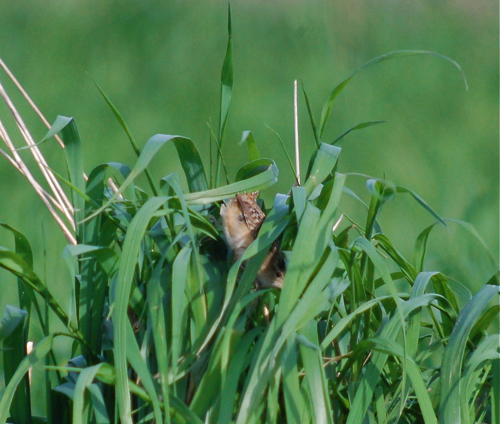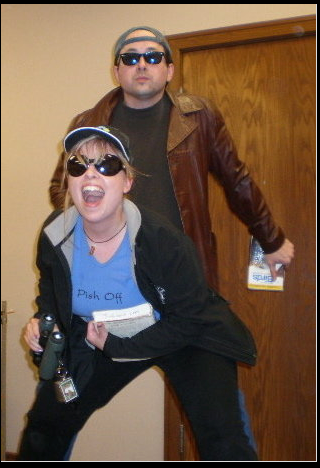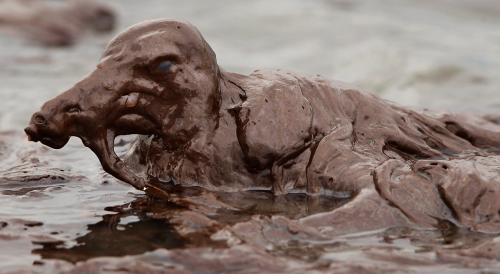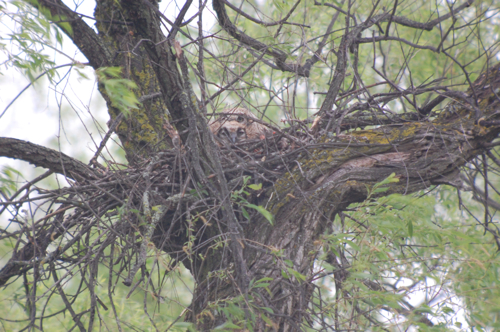 My spring travels are almost finished and each day I feel like I find myself in a new office. When not at the park service, the above photo is what my office looks like. Some cubicle view, huh? The only downside is that I have the occasional misstep into a badger hole. Fortunately, no badgers have confronted me on this faux pas, which makes me suspect shenanigans on their part as the holes are well hidden in the tall grasses.
My spring travels are almost finished and each day I feel like I find myself in a new office. When not at the park service, the above photo is what my office looks like. Some cubicle view, huh? The only downside is that I have the occasional misstep into a badger hole. Fortunately, no badgers have confronted me on this faux pas, which makes me suspect shenanigans on their part as the holes are well hidden in the tall grasses.

Here's one of my office mates--the horned lark. Don't let that face fool you into thinking he's constantly reminding all of us to stay on task. He has a habit of taking to the air, hanging right above me for minutes at a time and singing. It's pretty cool to actually see that behavior...and yet so vexing when I try to get a photo or a video of it. Some day, Mr. Horned Lark, some day. Yes indeed, that photo of your territory display will be mine.

I'm practically tripping over the vesper sparrows and their song greets me every morning. The feed around me in the field and get so close I almost wonder if they are watching me? I think I attract insects and kick seeds and they are more interested in that.

And speaking of insects, last week about killed me. I got covered in black flies--something I did not expect in southern Minnesota. For some reason, I always thought of them as a north woods pest, yet their irritation seems to not be. limited to wooded habitat. I now have a biting creature that I detest more than noseeums and ticks. They flew up my nose, down my shirt, into my ear canals and into my mouth if I was foolish enough to open it--good grief, at least chiggers stay below the knee.
I sprayed myself with my Deep Woods OFF to no avail. Suspecting that I had an old bottle, I purchased a new one at lunch time. The black flies treated it more like hollandaise sauce rather than repellent. I asked Twitter and researched the Internet and found that the only thing that helps is 100% DEET and that's not always a guarantee. Other than that, permethrin on your clothing or beekeeper netting works well. I didn't really want to spend 10 hours in my bee suit and as much as using a product that demands I only put on my clothes not my skin (and then leave my clothes to dry for several hours before putting them on) kinda scared me, I was desperate. I purchased some permethrin and invested in a boony hat with bug netting. So far today, I've yet be bitten. We'll see how this evening goes.

And it's not always all bad. I do get some cool views as I work. This is last week's sunset.
 Another benefit is that I got to watch a sedge wren delurk itself. I hear one quite a bit, but most of the time, the singing happens behind grasses and I can't see it. The closest I came was the above photo until...
Another benefit is that I got to watch a sedge wren delurk itself. I hear one quite a bit, but most of the time, the singing happens behind grasses and I can't see it. The closest I came was the above photo until...

He popped up! Cute. Am I the only one who thinks they kind of sound like dickcissels?
And, as I frequently use my blog as a catch all for travel notes so if I return to an area, I can remember place I enjoyed eating, weird hotels, etc. Here's a note:
My work for this particular project leaves me with a large chunk of the afternoon free and wondered what my chances of find an internet coffee shop with a decent lunch would be. Early on, things looked bleak as I stumbled upon a train themed restaurant. Though the decor and staff was charming, the food was not. The only other vegetable on the salad bar besides head lettuce was a dish full of black olives (that's not an exaggeration). The daily special for that cafe was battered cottage cheese deep fried and served with "white sauce" served on a slice of ham.
No, I didn't try it. I saw that someone next to me ordered it and it looked even less appetizing than it sounded.
But then I found SiJambo, a charming little coffee shop in Windom that had a pretty good salad bar with a cucumber salad and tasty paninis. I warned the staff that I would be camping out for a few hours when I visited and they've been down right sweet about it. In Minneapolis, if you overstay your welcome at an Internet Cafe, the staff will give you glares to get you to leave (or in the case of the Urban Bean, the owner just shuts off the internet until the undesired leaves). Here, they include me in conversations and even offered me free cake.
Also, the Earth Inn Motel in Jackson, MN is inexpensive, comfortable with reliable wireless and the owners are a hoot. Wednesday night is free dessert night.

 Hey--Non Birding Bill and I are performing! We wrote a show several years ago called Play on Birds. It's a bunch of sketches that lovingly pokes fun at birds, bird watching and bird feeding. We've performed it for the Minnesota Fringe Festival and even at a few bird festivals around the country. Some of the sketches include:
Hey--Non Birding Bill and I are performing! We wrote a show several years ago called Play on Birds. It's a bunch of sketches that lovingly pokes fun at birds, bird watching and bird feeding. We've performed it for the Minnesota Fringe Festival and even at a few bird festivals around the country. Some of the sketches include:
 I was archiving some photos and found this photo from this year's Detroit Lakes Festival of Birds of a great horned owl nest with 2 chicks. I figured the least I could do is post this photo after yesterday's link to a flycatcher eating what appears to be Cthulu.
I was archiving some photos and found this photo from this year's Detroit Lakes Festival of Birds of a great horned owl nest with 2 chicks. I figured the least I could do is post this photo after yesterday's link to a flycatcher eating what appears to be Cthulu. My spring travels are almost finished and each day I feel like I find myself in a new office. When not at the park service, the above photo is what my office looks like. Some cubicle view, huh? The only downside is that I have the occasional misstep into a badger hole. Fortunately, no badgers have confronted me on this faux pas, which makes me suspect shenanigans on their part as the holes are well hidden in the tall grasses.
My spring travels are almost finished and each day I feel like I find myself in a new office. When not at the park service, the above photo is what my office looks like. Some cubicle view, huh? The only downside is that I have the occasional misstep into a badger hole. Fortunately, no badgers have confronted me on this faux pas, which makes me suspect shenanigans on their part as the holes are well hidden in the tall grasses.



 Another benefit is that I got to watch a sedge wren delurk itself. I hear one quite a bit, but most of the time, the singing happens behind grasses and I can't see it. The closest I came was the above photo until...
Another benefit is that I got to watch a sedge wren delurk itself. I hear one quite a bit, but most of the time, the singing happens behind grasses and I can't see it. The closest I came was the above photo until...




